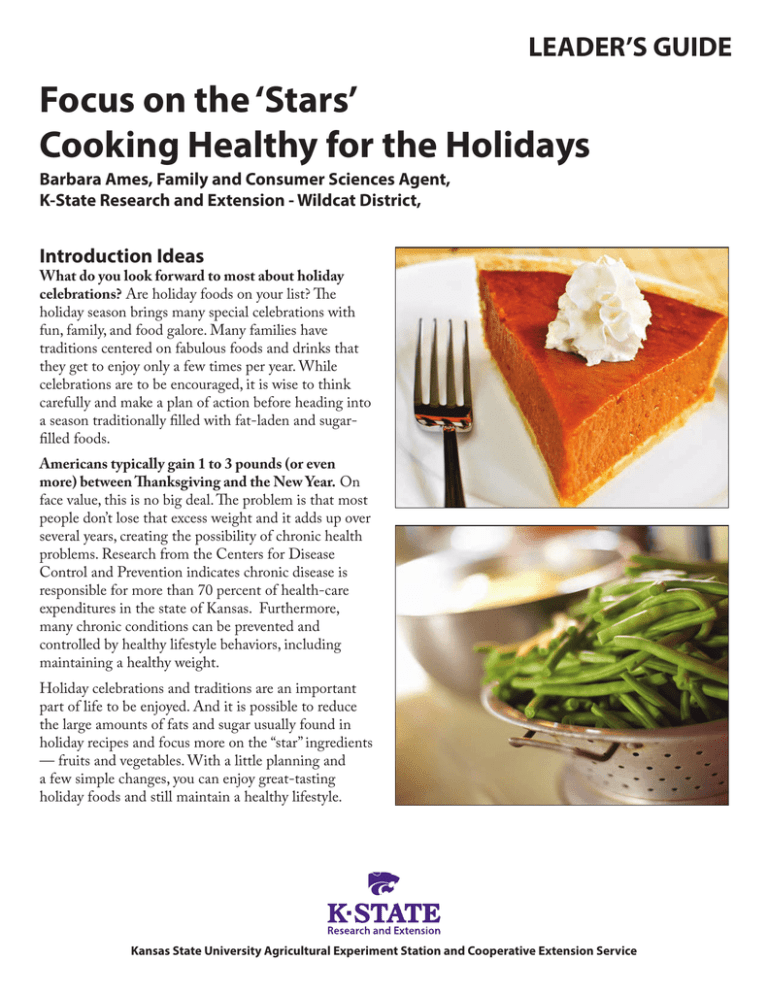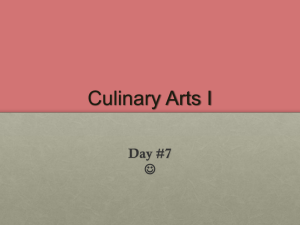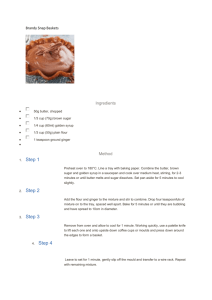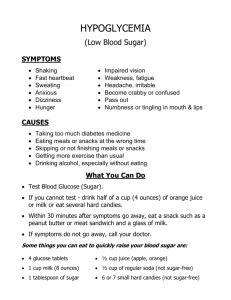
LEADER’S GUIDE
Focus on the ‘Stars’
Cooking Healthy for the Holidays
Barbara Ames, Family and Consumer Sciences Agent,
K-State Research and Extension - Wildcat District,
Introduction Ideas
What do you look forward to most about holiday
celebrations? Are holiday foods on your list? The
holiday season brings many special celebrations with
fun, family, and food galore. Many families have
traditions centered on fabulous foods and drinks that
they get to enjoy only a few times per year. While
celebrations are to be encouraged, it is wise to think
carefully and make a plan of action before heading into
a season traditionally filled with fat-laden and sugarfilled foods.
Americans typically gain 1 to 3 pounds (or even
more) between Thanksgiving and the New Year. On
face value, this is no big deal. The problem is that most
people don’t lose that excess weight and it adds up over
several years, creating the possibility of chronic health
problems. Research from the Centers for Disease
Control and Prevention indicates chronic disease is
responsible for more than 70 percent of health-care
expenditures in the state of Kansas. Furthermore,
many chronic conditions can be prevented and
controlled by healthy lifestyle behaviors, including
maintaining a healthy weight.
Holiday celebrations and traditions are an important
part of life to be enjoyed. And it is possible to reduce
the large amounts of fats and sugar usually found in
holiday recipes and focus more on the “star” ingredients
— fruits and vegetables. With a little planning and
a few simple changes, you can enjoy great-tasting
holiday foods and still maintain a healthy lifestyle.
Kansas State University Agricultural Experiment Station and Cooperative Extension Service
Educational Goals
•If possible, choose one or more of the suggested
teaching activities to reinforce the lesson.
•Call participants’ attention to the “Tasty,
Healthier Foods Possible” section of the fact
sheet and share that some of the modified recipes
may still contribute more calories per serving than
the average person should regularly consume.
However, let them know that the recipes are more
healthful, calorie-saving alternatives compared to
traditional recipes.
•Encourage participants to complete and return
the Participant Survey on page 7 of this leader’s
guide.
As a result of this lesson participants will:
•have a new understanding of the effect of adding
additional fat and sugar to recipes using fruits and
vegetables,
•gain ideas for more healthful ways to prepare
favorite holiday foods, and
•be motivated to think of ways to make simple
modifications to other favorite recipes.
Intended Audience
Anyone involved in choosing recipes or preparing
meals for holidays or other special occasions.
Suggested Teaching Activities
Suggested Program Preparation
•A Powerpoint presentation of this lesson is
available upon request from Barbara Ames,
Wildcat District Family and Consumer Sciences
Agent, at bames@ksu.edu or 620-331-2690.
•Choose one of the recipes included in the
Leader’s Guide to prepare for the group to taste.
Or, if possible, have several people who will be
attending prepare a different recipe in advance for
the group to taste. If desired, enlarge and print
the related comparison chart to display next to
each food during the tasting. Participants may be
surprised at how good the lighter version recipes
taste and may like to see the amount of calories
they can save by making a few easy changes.
•Encourage attendees to bring a favorite holiday
recipe not included in the lesson. In response to
recipe modification ideas mentioned in the lesson,
lead some group discussions regarding healthful
changes attendees could make to their own favorite
recipe while maintaining great taste.
•Lead a group discussion about favorite herbs,
spices, and seasoning blends that can be used to
enhance flavor in place of some fat and sugar.
•Challenge participants to choose and write down
one or more recipes to share with family members
at the holidays.
•Review this leader’s guide and the related fact
sheet. If desired, review the website resources listed
in these materials.
•Secure a copy of the Powerpoint presentation that
accompanies this lesson, if desired.
•Gather copies (or make photocopies) of the fact
sheet and participant survey for each audience
member.
•Make photocopies of the recipe section from this
leader’s guide for each participant.
•Have pens or pencils available.
Suggestions for Presenting
the Lesson
•If using a Powerpoint presentation, set up
necessary equipment and load Powerpoint
presentation for use in sharing the lesson.
•Begin by posing a question to your audience to
capture their attention and get them thinking
about the topic at hand. Possible questions could
be: “What do you look forward to most about
holiday celebrations?” or “What is a favorite holiday
food tradition for your family?”
•Discuss the concept of “star” ingredients and
how it relates to holiday foods. Discuss the chart
outlining the amount of added sugar in sweetened
applesauce. If desired, have samples of sweetened
and unsweetened applesauce for each person
to taste and compare to determine if the extra
sweetness is worth the additional calories which
must be burned.
•Review the five “star” foods in the fact sheet and
discuss tips for more healthful preparation and the
information in the comparison charts.
Suggested Community Awareness
Activities
•Present this program to already-established
community groups such as social clubs, service
organizations, or church groups.
2
Resources
•Share a display and distribute fact sheets from this
lesson at community health fairs or county health
clinics. The display could include some enlarged
copies of the Dare to Compare Recipe Charts to
pique interest in the amount of calories which can
be saved.
•Before the holidays, share the basics of this lesson
in a news column sent to your local newspaper.
Choose MyPlate, United States Department of
Agriculture, www.ChooseMyPlate.gov
Epicurious website, www.epicurious.com/recipesmenus
Fix It Fresh! Fruits and Vegetables Recipes Series, Mary
Meck Higgins, Ph.D., R.D., L.D., CDE, Assistant
Professor, Department of Human Nutrition. Kansas
State University Agricultural Experiment Station
and Cooperative Extension Service, Manhattan,
Kan.
www.ksre.ksu.edu/HumanNutrition/doc10559.ashx
Author
Barbara Ames
Family and Consumer Sciences Agent
K-State Research and Extension - Wildcat District
410 Peter Pan Road, Suite B
Independence, KS 67301
620-331-2690
bames@ksu.edu
Eat Smart, Move More North Carolina, Holiday
Challenge website,
myeatsmartmovemore.com/WordPress/recipes-2/
holiday-challenge/
The Good Housekeeping Cookbook, edited by Zoe
Coulson, The Hearst Corporation, Copyright
MCMLXXIII
Reviewers
Mary Meck Higgins, Associate Professor and
Extension Specialist, Human Nutrition, Kansas State
University
Healthy Holiday Cooking, University of Nebraska
Lincoln Extension,
www.extension.org/pages/24761/healthyholidaycooking
Gayle Price, Extension Specialist, Family and
Consumer Sciences, K-State Research and Extension Southeast Area
Healthy Season Side Dishes and Salads and Snacks,
Healthy, Thrifty Holiday Cooking: Resource
Library: SNAP-Ed Connection, USDA, National
Agricultural Library, Food and Nutrition
Information Center. snap.nal.usda.gov/resourcelibrary/winters-abundance/healthy-thrifty-holidaycooking
New Revised Edition Taste of Home Cookbook, 2008,
Reiman Media Group, Inc., ISBN 978-089821666-0
VeryBestBaking: Bake the Very Best website,
www.verybestbaking.com/Recipes.aspx
Walking Calories Calculator,
walking.about.com/library/cal/uccalc1.htm
3
•½ cup orange juice concentrate
•1 teaspoon grated lemon peel
•¼ cup chopped pecans, optional
1. Scrub sweet potatoes and cut each into 4 to 6
pieces. In a covered saucepan, boil sweet potatoes in
just enough water to cover. When they are forktender (about 15 to 20 minutes), drain. Remove
skin and any bad spots.
2. Cut potatoes into ½-inch slices. Place in a square
8-inch by 2-inch baking dish sprayed with nonstick cooking spray.
3. In a small saucepan, combine brown sugar and
cornstarch. Whisk in orange juice concentrate and
lemon peel. Bring to a boil, cook, and stir for 1
to 2 minutes or until thickened. Pour over sweet
potatoes. Sprinkle with pecans if desired.
4. Bake uncovered at 325°F for 25 to 30 minutes or
until sweet potatoes are heated through and sauce
is bubbly.
Source: Recipe provided courtesy of Taste of Home magazine.
Find more great recipes at www.tasteofhome.com.
Nutrition per ¾-cup serving (without pecans):
120 calories, 0 fat, 0 cholesterol, 20 mg sodium, 30 g
carbohydrate, 2 g fiber, 20 g sugars, 1 g protein.
My Holiday Plate
Recipes
Pineapple Sweet Potatoes
Makes 4 servings.
•4 small fresh sweet potatoes or yams
•1 cup (about 12 ounces) pineapple tidbits or
crushed pineapple, in juice, drained
•1 teaspoon ground cinnamon
•2 teaspoons margarine
•3 tablespoons chopped pecans, optional
1. Scrub sweet potatoes and cut each into 4 pieces.
In a covered saucepan, boil sweet potatoes in just
enough water to cover. When they are fork-tender
(about 15 to 20 minutes), drain. Remove skin and
any bad spots.
2. Preheat oven to 350°F. Spray an oven-proof dish
with non-stick cooking spray.
3. Mix pineapple and cinnamon. Put half of the
pineapple mixture in a dish and then half the sweet
potato pieces over the pineapple. Repeat. Place
margarine on top of potatoes, sprinkle with nuts,
and bake for 45 minutes.
Source: K-State “Fix It Fresh!”
Nutrition per 3/4-cup serving (without pecans):
160 calories, 2 g fat, 0 cholesterol, 90 mg sodium, 34 g
carbohydrate, 5 g fiber, 12 g sugar, 2 g protein.
Healthier Green Bean Casserole
Makes 9 servings.
•1 can (10¾ ounces) reduced-fat cream of
mushroom soup
•½ cup fat-free sour cream
•¼ cup fat-free milk
•2 cans (15 ounces each) drained green beans or two
9-ounce bags frozen green beans
•½ cup canned French-fried onions (See note
below.)
1. Mix soup, sour cream, and milk in 2-quart
casserole.
2. Stir in beans and bake uncovered at 350°F until
mixture is bubbly — about 40 minutes.
3. Sprinkle onions on top and cook for 5 more
minutes.
Source: North Carolina Eat Smart, Move More.
Nutrition per ½-cup serving: 100 calories, 4 g fat,
5 mg cholesterol, 230 mg sodium, 12 g carbohydrate,
2 g fiber, 3 g sugars, 3 g protein.
Citrus Sweet Potatoes
Makes 6 servings.
•3 medium sweet potatoes, peeled
•3 tablespoons packed brown sugar
•1½ teaspoons cornstarch
Note: For extra calorie and fat savings, consider gently
cooking fresh onions in a non-stick skillet to use as
topping instead of purchased French-fried onions.
4
Green Bean Sauté
3. Add cream cheese, sour cream, milk, salt, garlic
powder, and pepper. Beat until smooth, stir in
chives, and sprinkle with paprika.
Source: Recipe provided courtesy of Taste of Home magazine.
Find more great recipes at www.tasteofhome.com.
Nutrition per ½ cup serving: 80 calories, 1g fat, 5 mg
cholesterol, 150 mg sodium, 15 g carbohydrate, 1 g
fiber, 2 g sugars, 3 g protein.
Makes 6 servings.
•1 cup sliced onion
•1 cup sliced mushrooms
•1 teaspoon minced garlic
•1 can (16 ounces) cut green beans
1. Spray a skillet with non-stick cooking spray. Over
medium heat, cook onions, mushrooms, and garlic
until onions are soft.
Yogurt Mashed Potatoes
2. Add drained green beans and heat thoroughly.
Makes 10 servings.
•4 cups potatoes, peeled, cut into eighths
(about 2 pounds as purchased)
•¼ cup fat-free milk
•1¼ cups plain fat-free yogurt
•4 green onions, sliced
•½ to 1 teaspoon garlic powder, or desired seasoning
•Salt and pepper to taste
•Chopped fresh parsley
1. Place potatoes in microwave-safe dish. Add milk.
Cover tightly and cook on high until potatoes are
tender but not mushy, about 12 minutes.
2. Meanwhile, combine yogurt, green onions, and
garlic powder in a bowl.
3. Remove potatoes from microwave, add yogurt
mixture, and mash roughly.
4. Season with salt and pepper and garnish with
parsley.
Source: Adapted from Epicurious.com.
Nutrition per ½ cup serving (without added salt):
70 calories, 0 g fat, 0 mg cholesterol, 25 mg sodium,
16 g carbohydrate, 1 g fiber, 3 g sugars, 3 g protein.
Light ‘n’ Creamy Mashed Potatoes
Light Pumpkin Pie
Source: USDA Snap-Ed Connection.
Nutrition per ½-cup serving: 35 calories, 0 g fat, 0 mg
cholesterol, 200 mg sodium, 6 g carbohydrate, 2 g fiber,
2 g sugars, 2 g protein.
Makes 14 servings.
•6 cups quartered, peeled potatoes
(about 3 pounds as purchased)
•4 ounces fat-free cream cheese
•½ cup reduced-fat sour cream
•½ cup fat-free milk
•½ teaspoon salt
•¼ teaspoon garlic powder
•¼ teaspoon ground black pepper
•1 tablespoon minced fresh chives
•Dash of paprika
1. Place potatoes in a large saucepan and cover with
water. Bring to a boil. Reduce heat, cover, and boil
gently for 15 to 20 minutes or until tender. Drain.
2. In a large mixing bowl, mash the potatoes with
electric mixer.
Makes 8 servings.
•1 cup ginger snap cookies
•1 can (15 ounces) pumpkin
(not pumpkin pie filling)
•½ cup egg whites (about 4)
•½ cup sugar
•2 teaspoons pumpkin pie spice
•1 can (12 ounces) evaporated fat-free milk
1. Preheat the oven to 350°F. Spray 9-inch round
glass pie dish with nonstick cooking spray.
2. Grind the ginger snap cookies in a food processor.
Pat the cookie crumbs into the pan evenly.
3. Mix the rest of the ingredients in a large mixing
bowl. Pour into the crust and bake until knife
inserted in center comes out clean, about 45
5
minutes. Cool on wire rack for 2 hours. Serve
immediately or cover and refrigerate.
Source: North Carolina Eat Smart, Move More.
Nutrition per ⅛ of recipe: 220 calories, 4.5 g fat,
0 mg cholesterol, 160 mg sodium, 39 g carbohydrate,
3 g fiber, 28 g sugars, 7 g protein.
Crustless Pumpkin Pie
Makes 8 servings.
•¾ cup granulated sugar
•1 teaspoon ground cinnamon
•½ teaspoon salt
•½ teaspoon ground ginger
•¼ teaspoon ground cloves
•2 large eggs
•1 can (15 ounces) pumpkin (not pumpkin pie
filling)
•1 can (12 ounces) evaporated fat-free milk
•Reduced-fat whipped topping, optional
1. Spray 9-inch round glass pie dish with nonstick
cooking spray. Preheat oven to 325°F.
2. Mix sugar, cinnamon, salt, ginger, and cloves in
small bowl.
3. Beat eggs in large mixing bowl. Stir in pumpkin
and sugar-spice mixture. Gradually stir in
evaporated milk. Pour into pie dish.
4. Bake for 55 to 60 minutes or until knife inserted
near center comes out clean. Cool on wire rack for
2 hours. Serve immediately or cover and refrigerate.
Top with whipped topping if desired.
Source: www.verybestbaking.com.
Nutrition for ⅛ of recipe (without topping): 140
calories, 1.5 g fat, 55 cholesterol, 210 mg sodium, 28 g
carbohydrate, 2 g fiber, 26 g sugar, 6 g protein.
1. Preheat oven to 375°F.
2. Peel apples, if desired, slice, and toss in a mixing
bowl with apple juice to coat.
3. Combine flour, both kinds of sugar, and oats in
another mixing bowl. Cut in margarine using two
knives until mixture is crumbly. Stir in almonds.
4. Spray a square 8-inch by 2-inch baking dish with
non-stick cooking spray. Pour apples into baking
dish and sprinkle with crumb mixture. Bake 45
minutes or until topping turns golden brown.
Source: North Carolina Eat Smart, Move More.
Nutrition per 1⁄9 of recipe: 200 calories, 8 g fat, 0 mg
cholesterol, 60 mg sodium, 33 g carbohydrate, 4 g fiber,
22 g sugars, 2 g protein.
Slow Cooker Baked Apples
Makes 9 servings.
•6 large baking apples (Granny Smith, Jonathan, or
Jonagold work well)
•3 tablespoons brown sugar
•½ teaspoon nutmeg
•1 teaspoon cinnamon
1. Quarter apples and remove core. Place in slow
cooker.
2. Mix sugar and spices and sprinkle over apples.
Cover and cook 4 hours on low or 2 hours on high,
stirring once after juice begins to form to more
evenly distribute seasonings.
Nutrition per 1⁄9 of recipe: 110 calories, 0 g fat, 0 mg
cholesterol, 0 mg sodium, 27 g carbohydrate, 4 g fiber,
21 g sugar, 1 g protein.
Fall Apple Crisp
Makes 9 servings.
•7 cups cored, sliced apples, about 2 pounds or
about 5 large apples (Granny Smith, Jonathan, or
Jonagold work well)
•⅓ cup apple juice
•½ cup whole wheat flour
•¼ cup sugar
•¼ cup packed light brown sugar
•½ cup rolled oats
•5 tablespoons soft tub margarine, cut into small
pieces
•3 tablespoons slivered almonds
6
Focus on the ‘Stars’: Cooking Healthy for the Holidays Participant Survey
We appreciate your opinions! Please help us make our programs better by taking about 5 minutes to answer the following
questions. Your participation is completely voluntary, and you may skip answering one or more questions if you wish. The
information that you share will be held in the strictest confidence. We will summarize it in reports, in order to evaluate our program.
We greatly value your participation. Thank you!
Strongly
Agree
Agree
Neither Agree
or Disagree
Disagree
Strongly
Disagree
1. As a result of this program, I improved my knowledge.
❏
❏
❏
❏
❏
2. As a result of this program, I plan to practice new
skills.
❏
❏
❏
❏
❏
3.As a result of this program, I intend to make at least
one healthy change in my eating habits.
❏
❏
❏
❏
❏
Strongly
Agree
Agree
Neither Agree
or Disagree
Disagree
Strongly
Disagree
❏
❏
❏
❏
❏
4. As a result of this program, I have also learned:
5. I plan to take action and/or change something in my
life (at home, at play, or at work).
6. If agree, please describe the actions or changes planned:
7. Additional Comments:
8. A K-State representative may contact me later to talk about this program (We are asking for your contact information so that we
may follow-up with you about what you learned from this program):
Yes: ❏No: ❏
9. If yes, my contact information is below (e.g., name, address, city, state, zip code, phone, and email):
Demographics
10. I am an adult:
❏ 18 to 29 Years
❏ 30 to 39 Years
❏ 40 to 49 Years
❏ 50 to 59 Years
❏ 60 to 69 Years
❏ 70+ Years
11. I am a youth:
❏ 0 to 4 Years
❏ 5 to 11 Years
❏ 12 to 17 Years
❏ Female
❏ Prefer not to respond
12. My gender:
❏ Male
13. My race:
❏ American Indian or Alaska Native
❏ Asian
❏ Black or African American
❏ Native Hawaiian or Pacific Islander
❏ White
❏ Prefer not to respond
14. My ethnicity:
❏ Hispanic / Latino
❏ Non-Hispanic/Non-Latino
15. For office use only: Coded identification number7
❏ Prefer not to respond
Publications from Kansas State University are available at: www.ksre.ksu.edu
Publications are reviewed or revised annually by appropriate faculty to reflect
current research and practice. Date shown is that of publication or last revision.
Contents of this publication may be freely reproduced for educational purposes.
All other rights reserved. In each case, credit Barbara Ames, Focus on the “Stars”:
Cooking Healthy for the Holidays, Leader’s Guide, Kansas State University, July 2013.
Kansas State University Agricultural Experiment Station and Cooperative
Extension Service
K-State Research and Extension is an equal opportunity provider and employer.
Issued in furtherance of Cooperative Extension Work, Acts of May 8 and June
30, 1914, as amended. Kansas State University, County Extension Councils,
Extension Districts, and United States Department of Agriculture Cooperating,
John D. Floros, Director.
MF3088 July 2013



